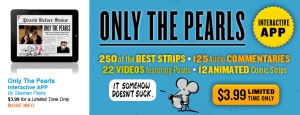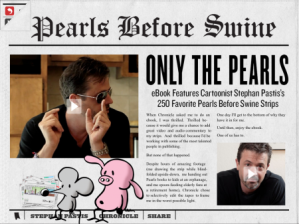 Full disclosure here – I am huge fan of Pearls Before Swine and of its creator, Stephan Pastis. In fact, it has been my great pleasure to not only meet Mr. Pastis, but to hang out with him as well. He is an amazing combination of funny and charming with tremendous charisma and yes, I do have a bit of a man crush. I must have made quite an impression on him as well as he actually corresponds with me from time to time. Quick side note – Mr. Pastis is Greek and he occasionally corresponds in Greek. In fact, I got a note from him just the other day. Did you know that the Greek word for “friend” is “stalker” and that “see you soon” is “restraining order?”
Full disclosure here – I am huge fan of Pearls Before Swine and of its creator, Stephan Pastis. In fact, it has been my great pleasure to not only meet Mr. Pastis, but to hang out with him as well. He is an amazing combination of funny and charming with tremendous charisma and yes, I do have a bit of a man crush. I must have made quite an impression on him as well as he actually corresponds with me from time to time. Quick side note – Mr. Pastis is Greek and he occasionally corresponds in Greek. In fact, I got a note from him just the other day. Did you know that the Greek word for “friend” is “stalker” and that “see you soon” is “restraining order?”
Man crush aside, I want to skip the normal praise I would heap upon him for his writing, drawing, artful commentary, being so handsome, etc. and praise him from a marketing perspective. This weekend I realized that Stephan Pastis is a genius!
Mr. Pastis and Chronicle Books just launched an interactive app for the iPad that is really more like an interactive book. If you’re a fan of Pearls, or any comic, you know that authors will often put out treasuries or collections of their strips. This interactive book is like a treasury of Mr. Pastis’s favorite 250 strips. What makes it even more fun is that he’s included video, audio commentary, animation and easter eggs (interactivity). I love reading his stuff anyway and this opportunity to peel back the curtain made it even more entertaining.
But it’s not just because it’s Pearls. I realized, after going through a second time, that this is how the future of books should be.
If you’ve read the biography of Steve Jobs, then you know that Steve Jobs himself thought the iPad could change the way people view ‘books’ and as an extension, learning. In fact, Apple has scheduled an event in NYC to discuss education, which many people think will be to announce new interactive textbook opportunities.
I have downloaded hundreds of books to my iPad and have noticed that, as the popularity of the iPad continues, that books are becoming more interactive. I have especially noticed this in children’s books. My 7-year old has been reading books on the iPad for a couple of years. The first books were just PDF versions of print books, but I have noticed that many books have begun to incorporate interactivity. It started out small – click on the word to hear pronunciation, click on a character to hear that character talk, sound effects, etc. The more interactivity in the book, the more interested my son was in the book. I think it’s too soon to say if this is good or bad. At a Parent – Teacher conference a few weeks ago, I was told that my son wasn’t doing very well in independent reading in class. I was a bit surprised considering how well he reads at home. When I asked him about it, he replied that books at school were boring. At first I thought he meant the subject matter, but I realized that he actually means that ‘paper’ books are boring.
I was quick to recognize the benefits of the iPad as it relates to digital signage and other marketing applications, but never gave much thought to what the iPad could do for books. I am such a bibliophile that I had the Rocket Book reader (that’s way back) and was an early adopter of the Sony eReader (hated it). So when the iPad came out, I was only interested in the fact that I could store a lot of books and how easy it was to purchase and download new books on a device that also let me do other stuff. I never thought much about what the books themselves could be / do.
Even when I noticed that my son preferred interactivity over regular print, I chalked that up to his age. Even as books (and later magazines) began to incorporate interactivity, I found them to be ancillary to the words themselves, not an integral part of the content. For example, Fortune magazine does a good job of offering additional material (such as videos), but I don’t need to click on them to understand the article. When I do click on them, I find them to be extensions of the article – like bonus features on a DVD. I have also been a part of designing interactive kiosks and other digital signage which required interactivity to deliver an end result (you are here . . . where do you want to go . . . here’s the path . . . download it to your mobile phone now, etc.), but the interactivity wasn’t part of the content. I personally believed that too much interactivity – especially with books – was a bad thing.
Until now, which is why Stephan Pastis is a genius.
His app / ebook, whatever you want to call it, is the first time I felt that interactivity was an integral part of the story. Yes, I could read the strips and get the humor, but the context in which he places them makes them that much more enjoyable. I realized that I want all iBooks to be like this.
I want to be able to read, say Freakonomics, on the iPad just like I would a book, but I would love the opportunity to click and get more detail – see data – watch a video of how the formulas play out, etc. I want interactivity not just because a developer knows how to put it in, but because it truly enhances my experience. I think the closest would be director commentary on a DVD. I think hearing the thoughts of a director / actor, whatever really can enhance the viewing experience, but those commentaries are usually given over the top of a movie. It’s like having people talk next to you in the movie theater. Well, as cool as that feature is, it required me to watch the movie and then watch it again with commentary. I, personally, don’t really want to watch the same movie twice.
I have always grasped the need to have hardware offer interactivity to content – and generally how that should go, but I admit that I was a bit behind the curve on the content itself being interactive without being annoying. I get what Steve Jobs was talking about. I have to admit that I am a little sad about what this may mean for books (because I love holding them, the smell, the feel of the paper, etc.), but I think there will always be a place for both. Like everything in our industry, I think we’ll find that some people will “get” what works best on an iPad and what doesn’t. I suspect that we’ll see a rash of people slapping interactivity on books and we’ll probably see a bump in the sales of interactive books, because people who make them can and people who read them want the feature. It’ll probably be the QR craze of 2011 all over again.
My final thought (in this way too long rambling commentary) is that what the future holds in interactivity in iBooks will be based on economics. It seems that there are two economic approaches available. One is to increase the price of the content. For example, I could buy an iBook for $7.99 or an enhanced version for $9.99. If I like the content and have seen previous value of interactivity, then I am probably willing to pay the extra $2 or so (give / take). I doubt I’m willing to pay much more than that when, at the core, I really just want the content. The other option is to offer new content as a stand alone (which is what this Pearls app) and charge a reasonable price ($3.99). This can really work out better, because I’m willing to pay a higher price point ($3.99 vs $2.00) for the interactive content. There will be some give and take to determine which route provides a better return, but it’s just math at that point.
When it’s all said and done, the truth is that I am a big fan of Pearls Before Swine and Stephan Pastis and I’m pretty much going to buy whatever he puts out . . . because he’s awesome . . . and a genius . . . and funny . . . and nice.
My real hope is that he reads this and invites me out for a beer sometime. If that happens then you can expect to see a similar blog about Charlize Theron.
# # #
We build strategies and everything that goes with them.
Some of the largest organizations in the world, including many in the mortgage and finance industries, trust us with the most important aspects of their business. From defining clients’ brands and identities to developing ongoing campaigns in a variety of media, we provide the communications and measurement tools to move them forward. Applying our experience and dedication to the media and the message, bloomfield knoble handles every detail of our clients’ strategic marketing initiatives.


